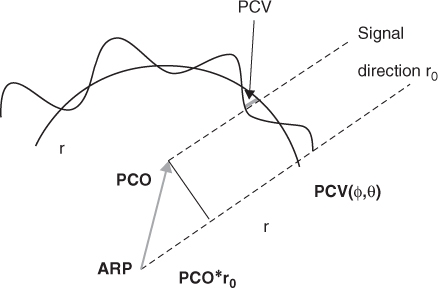Appendix B
The phase centre of a practical antenna varies in different azimuth and elevation angles, a phenomenon called phase centre dispersion. The antenna phase centre can only be kept relatively stable within a certain range of directions. The concepts of average phase centre, phase centre offset and phase centre variation are introduced to describe fully the characteristics of antenna phase response.
The average phase centre of an antenna is defined as the mean location of the antenna phase centre over a certain range of directions. The antenna reference point (ARP) is defined as the geometric centre of the antenna. The difference between the average phase centre and the antenna reference point is regarded as the phase centre offset (PCO). The offset between the phase centre in a particular direction and the average phase centre is known as phase centre variation (PCV) in that direction. These three parameters are illustrated in Figure B.1.
Figure B.1 Illustration of ARP, PCO and PCV [1]. Reproduced by permission of © 2010 IEEE.

Typical antenna installations for surveying use the ARP as the reference point for phase measurements, so a correction must be made to allow for the PCO in the direction of the satellite signals. The average phase centre, or PCO, can be found by minimising the cost function:
In order to improve the reliability and accuracy of the GNSSs, we have ...

